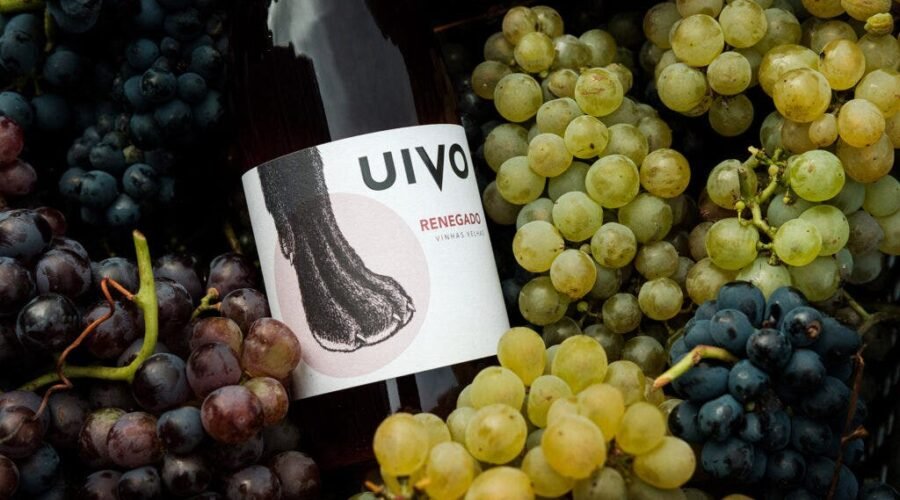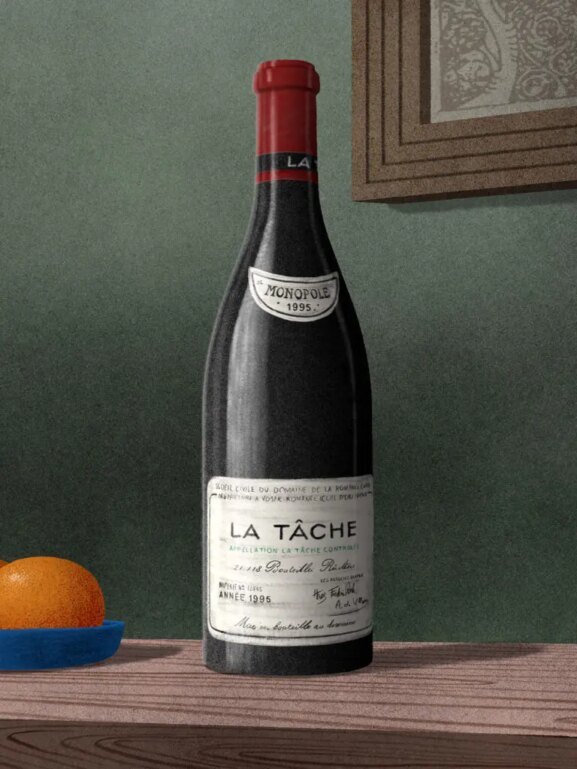After Nearly Disappearing, This Chillable Portuguese Red Wine Is Cool Again
A bit of trend chasing in the wine industry is understandable. Whether it’s the big-bigger-biggest arms race of the late ‘90s, or the misguided dogma of the “Anything But Chardonnay” movement, huge swaths of the wine industry have looked to cash in on the mood of the moment.
A quarter-century into the new millennium, chillable reds have now swept into fashion for global drinkers, with serious restaurant programs even carving out categorical space for them. One country in particular, though, has quietly but confidently been hustling to promote it as a patriotic calling card.
Portuguese Palhete (pronounced “pall-YET”), however, isn’t your typical red wine, though it’s usually categorized as one. It’s a relatively rare throwback style of field-blended, reds-plus-whites, kitchen-sink winemaking. But what’s more exceptional is that Portugal isn’t chasing any trends with it: they’ve been leading the way for almost a thousand years.
The Deep Roots of Portugal’s Palhete
From the eighth to 12th century, the vast majority of what we now call Portugal and Spain was ruled as “al-Andalus” by the Muslim caliphate from modern-day Morocco and Algeria. Though the Palhete tradition has pre-Roman roots, its official establishment as a distinct Portuguese winemaking method didn’t come until after Christian crusaders wrested back control of the Iberian Peninsula.
“Story has it that the Cistercian monks started producing Palhete around the 12th century in Alentejo and Beira Interior in Portugal,” says Lisbon-based Pedro Ramos, former Michelin-starred sommelier and current commercial manager for Clarets Portugal. “At first, planting different grape styles in the same plot would guarantee a chance of survival on the overall wine, if by any chance a couple of varieties would suffer from a specific disease or plague during that growth year.”
The vineyard would then be harvested all at once as a field blend—reds and whites alike—and co-fermented. Freshness, elegance, complexity and category-defying translucence in the resulting wine are all hallmarks of the ancient practice, with the hue inhabiting a spectrum in between darker rose and lighter red.
This winegrowing convention is a major contributing factor to Portugal’s embarrassment of viticultural riches. “These wines are often linked to old vines, which in themselves represent enormous genetic wealth,” says Jorge Rosa Santos, winemaker for several producers across Portugal and managing partner at Lés-a-Lés Vinhos and Vinhos Rosa Santos Família. He explains that the Palhete winemaking style is a direct reflection of this natural diversity, providing an authentically strong identity and sense of place.

The Preservation of Palhete—Against All Odds
Save for remote village winemaking, the ancient method teetered on the edge of extinction in the mid-20th century due to the authoritarian policies of Portugal’s Estado Novo dictatorship. In addition to other crimes against wine heritage, the regime enacted plans to convert certain regions into grain-producing monocultures—ripping up cherished old field-blend vineyards in the process—as well as forcing winemaking into cooperatives that often rewarded high alcohol content, inky color and copious vineyard yields.
// Create the element
var script_68b73dc4226db = document.createElement(“script”);
script_68b73dc4226db.innerHTML = `
window.googletag = window.googletag || {cmd: []};
googletag.cmd.push(function() {
var adType = “leaderboard”;
var mapping;
var lbmapping = googletag.sizeMapping()
.addSize([1024, 0], [[970, 250], [970, 90], [1, 1], [728, 90]])
.addSize([728, 0], [[728, 90], [1, 1]])
.addSize([320, 0], [[1, 1], [300, 50], [300, 100], [320, 50], [320, 100]])
.addSize([0, 0], [[1, 1], [320, 50]])
.build();; // Size mapping for leaderboard ads
var medrecmapping = googletag.sizeMapping()
.addSize([1024, 0], [[300, 600],[300, 250]])
.addSize([728, 0], [300, 250])
.addSize([320, 0], [[1, 1],[300, 250]])
.addSize([0, 0], [[1, 1], [300, 250]])
.build(); // Size mapping for med rectengle ads
if(‘/39808611/article_page/article_leaderboard_1’ == ‘/39808611/article_page/article_leaderboard_1’
|| ‘/39808611/article_page/article_leaderboard_1’ == ‘/39808611/article_page/article_leaderboard_2’
|| ‘/39808611/article_page/article_leaderboard_1’ == ‘/39808611/article_page/article_leaderboard_3’) {
mapping = googletag.sizeMapping()
.addSize([1920, 0], [[728, 90]]) // >= 1920px
.addSize([1440, 0], [[728, 90]]) // 1440px-1919px
.addSize([730, 0], [[300, 250]]) // 730px-1439px
.addSize([0, 0], [[320, 100], [320, 50], [300, 100], [300, 50], [300, 250]]) // Up to 729px
.build();
} else {
mapping = adType == ‘leaderboard’ ? lbmapping : medrecmapping;
}
googletag.defineSlot(‘/39808611/article_page/article_leaderboard_1’, [],
‘div-gpt-ad-68b73dc4226db’).addService(googletag.pubads()).defineSizeMapping(mapping);
googletag.pubads().enableSingleRequest();
googletag.pubads().collapseEmptyDivs();
googletag.display(‘div-gpt-ad-68b73dc4226db’);
});
`;
// Append the script to the body
document.body.appendChild(script_68b73dc4226db);
But stubborn pockets of winemaking cultural resistance held out, preserving the Palhete style over the decades. “This type of wine was always produced, and with high popularity, at least in our area,” says Ricardo Santos, founder and winemaker at revivalist operation XXVI Talhas in Alentejo’s Vidigueira district. “[but] Palhete was always produced by small producers.”
Recently, thanks to the tenacious efforts of Jorge, Ricardo and dozens of others across the country to reclaim heritage winegrowing and winemaking methods, the Palhete tradition has surged back to life as one of the country’s most distinctive dignitaries.

The Meeting of Trend and Tradition
Lewis Kopman, partner in Portuguese-centric importer Grossberg/Kopman Selections, didn’t expect Palhete to be a star on his roster. Yet over the past several years, it’s seen scorching sales in the New York market.
“I did not intend on being a company that imports a ton of Palhete wine, but that’s what has ended up happening,” he says. “We’ve sold about seven times as much Palhete as rosé over the life of our company.”
As chillable reds have gained popularity, there’s been a serendipitous synergy of trend meeting heritage. The kitchen-sink approach—with the involved grape varieties that vary from region to region and vineyard to vineyard—offers an aesthetic and flavor profile that’s seemingly made to order for the current generational shift in wine fashion. Zippy red berry notes mingle with spice, while the white grapes contribute a citrus and orchard fruit dimension, in a beguiling push and pull of both surprising depth and refreshing food-friendliness.
“Portugal has the most authentic tradition of producing that style of wine,” he says, adding that Portugal also likely has the greatest collection of old-vine, field-blended vineyards in Europe. “Palhete is a product that is of that vineyard. The vineyard is making the decision for you.”
When hunting down new placements for Palhete in the market, Kopman offers two distinct tactics depending on the buyer’s predisposition and needs: charming aesthetics or nerdy history. “There’s a very simple, easy pitch for these wines, but there’s also the hour-long podcast about them,” he says. “That’s to Palhete’s advantage, not disadvantage.”
From the sommelier’s perspective, Ramos in Lisbon says that there’s almost no wrong occasion or dish for it. Versatility is Palhete’s ultimate core attribute at the table, and it’s particularly adept at summertime service. It also earns bonus points as a conversation starter.
Portuguese Wine on the Rise
If the number of U.S. bakeries now serving Portuguese pastéis are any indication, there’s no doubt that Portuguese culture is finally getting some overdue attention in the international culinary scene. And perhaps more importantly than its effortless aesthetic appeal, Palhete ranks high among the traditional wine styles cleverly burrowing through the noise for the Portuguese tradition in a crowded global market.
// Create the element
var script_68b73dc422f49 = document.createElement(“script”);
script_68b73dc422f49.innerHTML = `
window.googletag = window.googletag || {cmd: []};
googletag.cmd.push(function() {
var adType = “leaderboard”;
var mapping;
var lbmapping = googletag.sizeMapping()
.addSize([1024, 0], [[970, 250], [970, 90], [1, 1], [728, 90]])
.addSize([728, 0], [[728, 90], [1, 1]])
.addSize([320, 0], [[1, 1], [300, 50], [300, 100], [320, 50], [320, 100]])
.addSize([0, 0], [[1, 1], [320, 50]])
.build();; // Size mapping for leaderboard ads
var medrecmapping = googletag.sizeMapping()
.addSize([1024, 0], [[300, 600],[300, 250]])
.addSize([728, 0], [300, 250])
.addSize([320, 0], [[1, 1],[300, 250]])
.addSize([0, 0], [[1, 1], [300, 250]])
.build(); // Size mapping for med rectengle ads
if(‘/39808611/article_page/article_leaderboard_2’ == ‘/39808611/article_page/article_leaderboard_1’
|| ‘/39808611/article_page/article_leaderboard_2’ == ‘/39808611/article_page/article_leaderboard_2’
|| ‘/39808611/article_page/article_leaderboard_2’ == ‘/39808611/article_page/article_leaderboard_3’) {
mapping = googletag.sizeMapping()
.addSize([1920, 0], [[728, 90]]) // >= 1920px
.addSize([1440, 0], [[728, 90]]) // 1440px-1919px
.addSize([730, 0], [[300, 250]]) // 730px-1439px
.addSize([0, 0], [[320, 100], [320, 50], [300, 100], [300, 50], [300, 250]]) // Up to 729px
.build();
} else {
mapping = adType == ‘leaderboard’ ? lbmapping : medrecmapping;
}
googletag.defineSlot(‘/39808611/article_page/article_leaderboard_2’, [],
‘div-gpt-ad-68b73dc422f49’).addService(googletag.pubads()).defineSizeMapping(mapping);
googletag.pubads().enableSingleRequest();
googletag.pubads().collapseEmptyDivs();
googletag.display(‘div-gpt-ad-68b73dc422f49’);
});
`;
// Append the script to the body
document.body.appendChild(script_68b73dc422f49);
“These wines are essentially communicated by word of mouth,” Jorge Rosa Santos says. “[It] doesn’t fit into conventional categories, and perhaps for this very reason, it gains traction where difference is celebrated.”
Bit by bit—despite suffering decades of previous authoritarian mismanagement and an achingly slow recovery—Portugal’s wine culture is finally returning to its rightful place among the world’s most worshipped viticultural treasures. And Palhete, with its combination of abundant modernist appeal and traditional, old-school moxy, is already proving a talented ambassador for the cause.
“It’s a really important part of the past, and the future, of Portuguese wine,” Kopman says. “More people in Portugal need to wake up to the authentic history of their wine. The world is coming to them.”
More Portugal Wine Coverage
- To understand Portuguese wine, start by learning these 8 grapes.
- Think you know Portugal’s Vinho Verde? Think again.
- Get to know Touriga Nacional, Portugal’s complex and ageworthy answer to Cabernet.
- A finicky French grape, Alicante, has become an unlikely star in Alentejo.
- Portugal’s traditional amphorae wines are becoming trendy again.

In the Shop
For Wine On-the-Go
This versatile messenger-style wine bag comes with removable bottle liners, a corkscrew and an aerator.
The post After Nearly Disappearing, This Chillable Portuguese Red Wine Is Cool Again appeared first on Wine Enthusiast.


